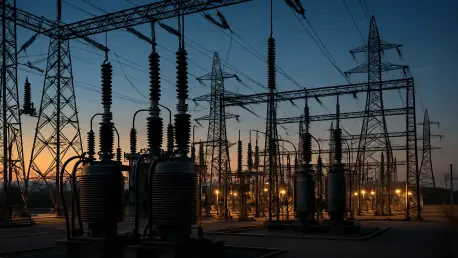A sudden power outage impacting nearly 4,000 customers in central Maryland has ignited a firestorm of concern over the state’s energy infrastructure, revealing deep-seated vulnerabilities that could threaten reliability for thousands more. This incident, which occurred due to an unplanned disconnection at the Brandon Shores Transmission Substation, left residents without electricity for hours and prompted urgent calls for energy conservation from Baltimore Gas and Electric (BGE). Far from an isolated event, this disruption has amplified fears about the fragility of the power grid, especially as demand for electricity continues to grow. State lawmakers, utility officials, and the governor’s office are now grappling with how to address these systemic issues, with debates centering on immediate fixes versus long-term sustainability. As Maryland faces the dual challenge of meeting current needs and preparing for future growth, this outage serves as a stark reminder of the stakes involved in maintaining a stable energy supply.
Addressing Grid Vulnerabilities
Immediate Impact of the Disruption
The unexpected power loss at the Brandon Shores Transmission Substation sent shockwaves through central Maryland, affecting thousands of households and businesses in a matter of hours. Described by PJM, the regional grid operator, as a transmission constraint rather than a resource shortage, the incident nonetheless restricted power delivery across the region for much of the day. BGE quickly urged customers to reduce energy usage to alleviate pressure on the system, a request that underscored the precarious balance of supply and demand. For many residents, this outage was more than an inconvenience—it was a source of anxiety, particularly for those already burdened by high utility costs. The event highlighted how even brief disruptions can have outsized effects on daily life, from interrupted work to compromised safety for vulnerable populations. This immediate fallout has fueled a broader conversation about whether the current infrastructure can withstand unexpected challenges without leaving communities in the dark.
Lawmaker Reactions and Calls for Action
Republican state lawmakers have seized on the outage as evidence of long-standing flaws in Maryland’s energy framework, voicing frustration over the state’s preparedness for such incidents. Delegate Brian Chisholm pointed to the critical importance of facilities like Brandon Shores in maintaining grid stability, arguing that concerns about reliability have been ignored for far too long. Meanwhile, Delegate Ryan Nawrocki emphasized that even if substation issues are to blame, the lack of sufficient energy supply elsewhere on the grid compounds the problem, making recovery from disruptions far more difficult. Both lawmakers expressed deep concern for residents facing not only the practical challenges of power loss but also the emotional and financial toll it exacts. Their statements reflect a growing impatience with the status quo, as they push for immediate interventions to shore up the system. This political pressure adds a layer of urgency to the debate, as elected officials seek to translate public distress into tangible policy changes.
Pathways to a Resilient Energy Future
BGE’s Response and Modernization Efforts
In the wake of the outage, BGE issued a statement acknowledging the disruption while noting that the precise cause remains under investigation. The company’s primary focus was on restoring service as quickly as possible, with assurances that no further load shedding was expected under current conditions. Beyond immediate resolution, BGE stressed the need for modernization to meet rising electricity demands and enhance system resilience. This forward-looking stance emphasizes the importance of investing in infrastructure upgrades to prevent similar incidents in the future. By prioritizing both reliability and sustainability, BGE aims to rebuild trust with customers who felt the brunt of the outage. Such commitments signal a recognition that temporary fixes are insufficient in an era of increasing energy needs, pushing the utility to explore innovative solutions that can adapt to evolving challenges while maintaining safe and dependable service for all.
State Leadership and Legislative Initiatives
Governor Wes Moore’s administration has also responded decisively, reaffirming a dedication to providing affordable and reliable power to every Marylander. Engaging actively with PJM and other state partners, the governor’s office is working to ensure grid stability and address the high costs often passed on to consumers. Recent legislation signed by Governor Moore aims to streamline in-state energy generation, including natural gas options, while offering relief through energy rebates. This dual approach seeks to balance short-term reliability with a broader vision of transitioning to cleaner, cost-effective energy sources. By tackling both immediate concerns and future aspirations, the administration hopes to create a framework that mitigates risks of outages while fostering sustainable growth. These efforts reflect a comprehensive strategy to overhaul the energy landscape, ensuring that incidents like the recent disruption become less frequent and less impactful over time.
Building a Stronger Grid for Tomorrow
Reflecting on the incident, it became clear that the outage at Brandon Shores was a critical wake-up call for all stakeholders involved in Maryland’s energy sector. State lawmakers have voiced their alarm over systemic weaknesses, pushing for swift action to protect residents from further hardship. BGE has taken steps to address the immediate crisis while laying out plans for modernization to bolster resilience. Meanwhile, Governor Moore’s administration has set a precedent by integrating legislative measures with long-term sustainability goals. Moving forward, the focus must shift to collaborative efforts that prioritize infrastructure investment, policy reform, and innovative technologies to enhance grid capacity. By learning from this disruption, Maryland has an opportunity to forge a path toward a more robust and adaptable power system. Addressing these challenges head-on will be essential to safeguard communities against future outages and ensure that energy reliability remains a cornerstone of the state’s progress.









